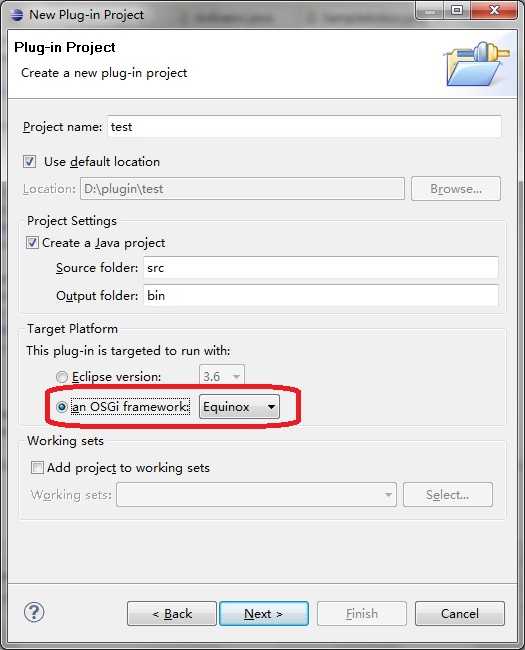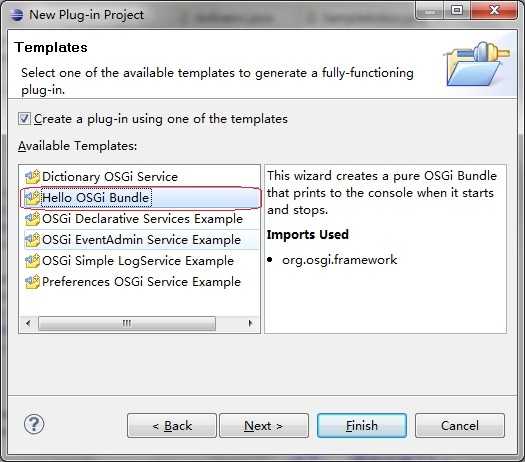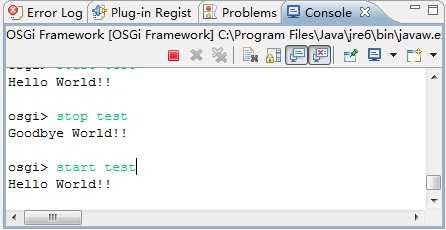标签:
1. 生成OSGi工程
首先打开新工程向导,选择创建Eclipse插件工程。在[目标平台(Target Platform)]选项中选择[OSGi 框架(OSGi framework)]。
图5-1 创建插件工程

在选择模板的时候选择,Hello OSGi Bundle后点击完成。
图5-2 选择OSGi模板

生成工程后,在Manifest编辑器中点击[启动框架(Launch the framework)]运行新生成的OSGi Bundle。执行后可能会出现大量的错误。原因是Eclipse中的OSGiBundle在OSGi框架中注册了,但是UI相关的部分没能启动。我们进入[运行设置(Run Configuration)],取消所有的Bundle绑定,只选中我们当前要测试的Bundle。(我自己作的工程即使都取消了运行也报错:(~~)
在框架运行时,向控制台窗口输入开始和停止指令,看一下效果吧。
图5-4 Hello OSGi

2. OSGi Service和Tracker
上一节我们制作了一个简单的在启动和停止时输出消息的Bundle。代码很简单的实现了BundleActivator接口的sart()和stop()方法,在其中利用System.out.println打出了信息。
代码1
public class Activator implements BundleActivator {
public void start(BundleContext context) throws Exception {
System.out.println("Hello World!!");
}
public void stop(BundleContext context) throws Exception {
System.out.println("Goodbye World!!");
}
}
在OSGi框架中为了生命周期管理提供了开始和停止方法,仅此而已,OSGi Bundle就可以运行起来了。OSGi框架有一种可以为多个Bundle提供作为共通(Common)使用的Service功能,称为OSGi Service。
代码2 最简单的OSGi Service
public class OSGiService {
public void doSomething(){
System.out.println("Running Common Service");
}
}
代码3 执行OSGi Service
public class Activator implements BundleActivator {
public void start(BundleContext context) throws Exception {
System.out.println("Hello World!!");
// 注册OSGi Service
context.registerService(OSGiService.class.getName(), new OSGiService(),
new Properties());
}
public void stop(BundleContext context) throws Exception {
System.out.println("Goodbye World!!");
// 生成Service Tracker
ServiceTracker tracker = new ServiceTracker(context,
OSGiService.class.getName(), null);
tracker.open();
// 取得Service
OSGiService service = (OSGiService) tracker.getService();
// 执行Service
service.doSomething();
}
}
我们看一下上面的Bundle执行的效果。
代码4
Hello World!! stop test Goodbye World!! Running Common Service osgi>
3. Bundel的安装和更新
OSGi框架在JavaVM不重启的情况下也可以安装和卸载Bundle。下面我们做一个新的Bundle,NewBundle在启动和停止时输出一行消息。
代码5 NewBundle
public class Activator implements BundleActivator {
public void start(BundleContext context) throws Exception {
System.out.println("New bundle start!!");
}
public void stop(BundleContext context) throws Exception {
System.out.println("New bundle stop!!");
}
}
将该工程导出到c盘根目录下,启动OSGi控制台输入install file:\\\C:\plugins\NewBundle_1.0.0.201008182238.jar。再通过ss命令确认bundle的安装。
代码6 Bundle的安装和卸载
osgi> install file:\\\C:\plugins\NewBundle_1.0.0.201008182238.jar Bundle id is 321 osgi> ss New Framework is launched. id State Bundle 321 INSTALLED NewBundle_1.0.0.201008182238 osgi> start NewBundle New bundle start!! osgi> uninstall NewBundle New bundle stop!! osgi> ss New Framework is launched. id State Bundle osgi>
上面代码说明,在卸载Bundle的时候会先调用stop方法。对Bundle的MANIFEST文件的描述方法作一个简单的总结如下表:
| 项目名 | 说明 |
| Manifest-Version | Jar包的Manifest文件指定了版本号,通常是1.0 |
| Bundle-ManifestVersion | Bundle的Manifest文件指定了版本,通常是2 |
| Bundle-Name | Bundle的名称 |
| Bundle-SymbolicName | Bundle的Synbo名称,OSGi中以这个名称注册 |
| Bundle-Version | Bundle的版本。在OSGi中有可能多个不同版本的同一Bundle共存 |
| Bundle-Activator | 管理Bundle生命周期的类名 |
| Bundle-Vendor | 定义了制作Bundle的组织名称 |
| Bundle-ActivationPolicy | 指定了Bundle启动的策略。 |
| Import-Package | 指定了Bundle引用的包 |
| Export-Package | 指定了Bundle向起他Bundle公开的包 |
| Required-Bundle | 指定了Bundle引用的Bundle |
Eclipse插件开发之基础篇(5) 制作OSGi Bundle
标签:
原文地址:http://www.cnblogs.com/Xsum/p/5140277.html